2016 Peugeot 508 battery
[x] Cancel search: batteryPage 108 of 371
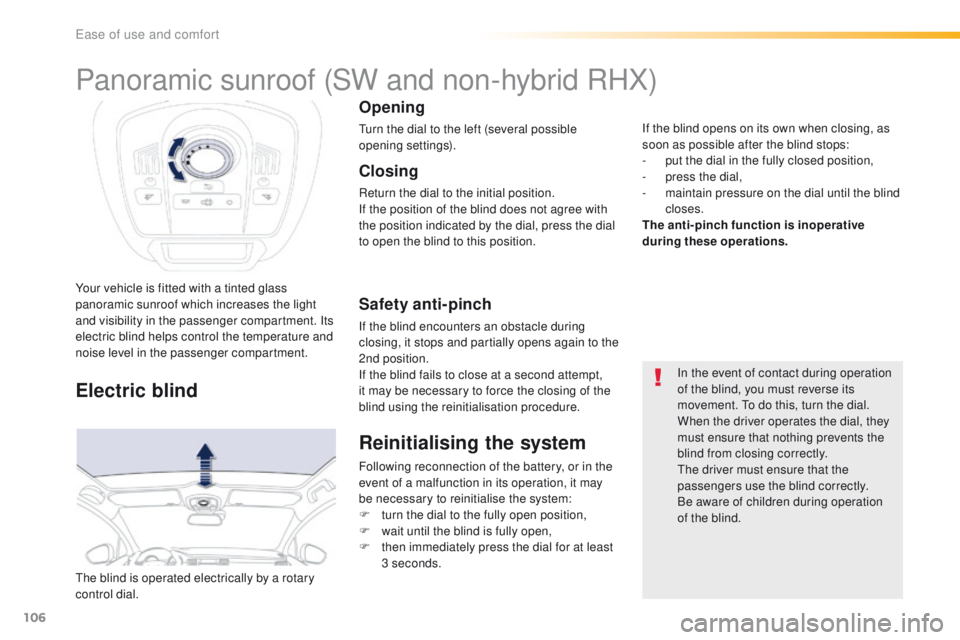
106
508_en_Chap03_ergonomie-et-confort_ed01-2016
Your vehicle is fitted with a tinted glass
panoramic sunroof which increases the light
and visibility in the passenger compartment. Its
electric blind helps control the temperature and
noise level in the passenger compartment.
th
e blind is operated electrically by a rotary
control dial.
Opening
turn the dial to the left (several possible
opening settings).
Safety anti-pinch
If the blind encounters an obstacle during
closing, it stops and partially opens again to the
2nd position.
If the blind fails to close at a second attempt,
it may be necessary to force the closing of the
blind using the reinitialisation procedure.
Closing
Return the dial to the initial position.
If the position of the blind does not agree with
the position indicated by the dial, press the dial
to open the blind to this position.
Electric blind
In the event of contact during operation
of the blind, you must reverse its
movement.
t
o d
o this, turn the dial.
When the driver operates the dial, they
must ensure that nothing prevents the
blind from closing correctly.
th
e driver must ensure that the
passengers use the blind correctly.
Be aware of children during operation
of the blind.
Reinitialising the system
Following reconnection of the battery, or in the
event of a malfunction in its operation, it may
be necessary to reinitialise the system:
F
t
urn the dial to the fully open position,
F
w
ait until the blind is fully open,
F
t
hen immediately press the dial for at least
3 seconds. If the blind opens on its own when closing, as
soon as possible after the blind stops:
-
p
ut the dial in the fully closed position,
-
p
ress the dial,
-
m
aintain pressure on the dial until the blind
closes.
The anti-pinch function is inoperative
during these operations.
Panoramic sunroof (SW and non-hybrid RHX)
ease of use and comfort
Page 121 of 371

119
508_en_Chap04_eclairage-et-visibilite_ed01-2016
Foglamp selection ring
the foglamps operate with dipped and main
beam headlamps.
Front and
rear foglamps
When the headlamps switch off with automatic
illumination of headlamps (AutO m odel) or when
the dipped beam headlamps are switched off
manually, the foglamps and sidelamps remain on.
F turn the ring rear wards to switch off the foglamps, the sidelamps will then switch off.
In good or rainy weather, both day
and night, the front foglamps and the
rear foglamps are prohibited. In these
situations, the power of their beams
may dazzle other drivers.
t
he
y should
only be used in fog or snow.
In these weather conditions, it is your
responsibility to switch on the foglamps
and dipped headlamps manually as the
sunshine sensor may detect sufficient
light.
Do not forget to switch off the front
foglamps and the rear foglamps when
they are no longer needed.
Rotate and release the ring:
F f or wards a first time to switch on the front
foglamps,
F
f
or wards a second time to switch on the rear
foglamps,
F
r
ear wards a first time to switch off the rear
foglamps,
F
r
ear wards a second time to switch of the
front fog lamps.
Lighting left on audible
signal
An audible signal when a front door
is opened warns the driver that the
vehicle's exterior lighting is on, with the
ignition off and in manual lighting mode.
In this case, switching off the lighting
stops the audible signal.
With the ignition off, if the dipped
headlamps remain on, the vehicle goes
into "
eC
O" mode to avoid discharging
the battery.
th
e lighting goes off when you switch
off the ignition, but you can always
switch it on again using the lighting
control stalk.
4
Lighting and visibility
Page 167 of 371
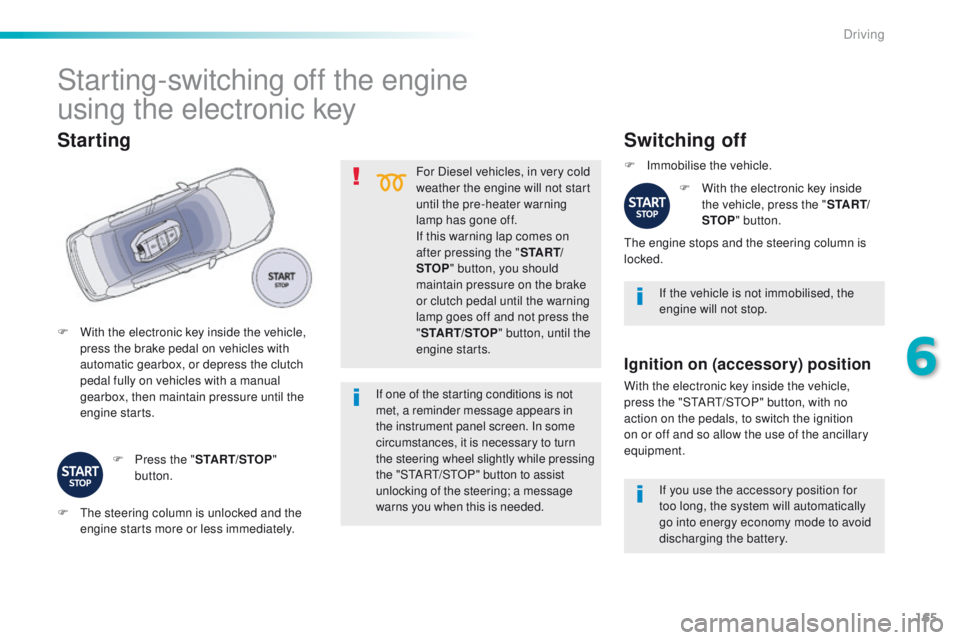
165
508_en_Chap06_conduite_ed01-2016
For Diesel vehicles, in very cold
weather the engine will not start
until the pre-heater warning
lamp has gone off.
If this warning lap comes on
after pressing the "S TA R T/
STOP " button, you should
maintain pressure on the brake
or clutch pedal until the warning
lamp goes off and not press the
" START/STOP " button, until the
engine starts. If the vehicle is not immobilised, the
engine will not stop.
Switching off
F Immobilise the vehicle.
F
W
ith the electronic key inside
the vehicle, press the " S TA R T/
STOP " button.
th
e engine stops and the steering column is
locked.
Ignition on (accessory) position
With the electronic key inside the vehicle,
press the "StA Rt/ StO P" button, with no
action on the pedals, to switch the ignition
on or off and so allow the use of the ancillary
equipment.
If one of the starting conditions is not
met, a reminder message appears in
the instrument panel screen. In some
circumstances, it is necessary to turn
the steering wheel slightly while pressing
the "S
tA
R
t/
S
tO
P" button to assist
unlocking of the steering; a message
warns you when this is needed.
F
W
ith the electronic key inside the vehicle,
press the brake pedal on vehicles with
automatic gearbox, or depress the clutch
pedal fully on vehicles with a manual
gearbox, then maintain pressure until the
engine starts.
Starting
F Press the " START/STOP"
button.
Starting-switching off the engine
using the electronic key
F the steering column is unlocked and the engine starts more or less immediately. If you use the accessory position for
too long, the system will automatically
go into energy economy mode to avoid
discharging the battery.
6
Driving
Page 172 of 371

170
508_en_Chap06_conduite_ed01-2016
Automatic release
the electric parking brake releases
automatically and progressively when you
press the accelerator:
F
M
anual gearbox: press down fully on the
clutch pedal, engage first gear or reverse,
press on the accelerator pedal and
move
off.
F
A
utomatic gearbox: select position D, M
or R then press on the accelerator pedal.
Full release of the parking brake is confirmed by:
-
t
he braking warning lamp and
the P warning lamp in the control
lever A going of f,
-
d
isplay of the message "Parking
brake of f ".
When stationary, with the engine running, do
not press the accelerator pedal unnecessarily,
as you may release the parking brake.
Before leaving the vehicle, check that
parking brake warning lamps in the
instrument panel and the control lever A
are on fixed, not flashing.
Immobilising the vehicle,
engine running
With the engine running and the vehicle
stationary, in order to immobilise the vehicle
it is essential to manually apply the parking
brake by pulling control lever A.
th
e application of the parking brake is
confirmed by:
-
i
llumination of the braking warning
lamp and of the P warning lamp in
the control lever A ,
-
d
isplay of the message "Parking
brake on".
When the driver’s door is opened, a loud beep
is heard and a message is displayed if the
parking brake has not been applied, unless the
gear lever is in position P (Park) in the case of
an automatic gearbox.
Particular situations
In certain situations (e.g. starting the engine),
the parking brake can automatically alter its
force. t
h
is is normal operation.
to a
dvance your vehicle a few centimetres
without starting the engine, but with the ignition
on, press on the brake pedal and release the
parking brake by pushing then releasing
control lever A .
t
h
e full release of the parking
brake is confirmed by the warning lamps in
the control lever A and in the instrument panel
going off and display of the message "Parking
brake of f ".
If a parking brake fault occurs while applied or
if the battery runs flat, an emergency release is
always possible.
In order to ensure correct operation and
so your safety, the number of successive
application/release operations of the parking
brake is limited to eight.
In the event of abuse, you are alerted by a
message "Parking brake faulty" and a warning
lamp flashes.
Driving
Page 173 of 371
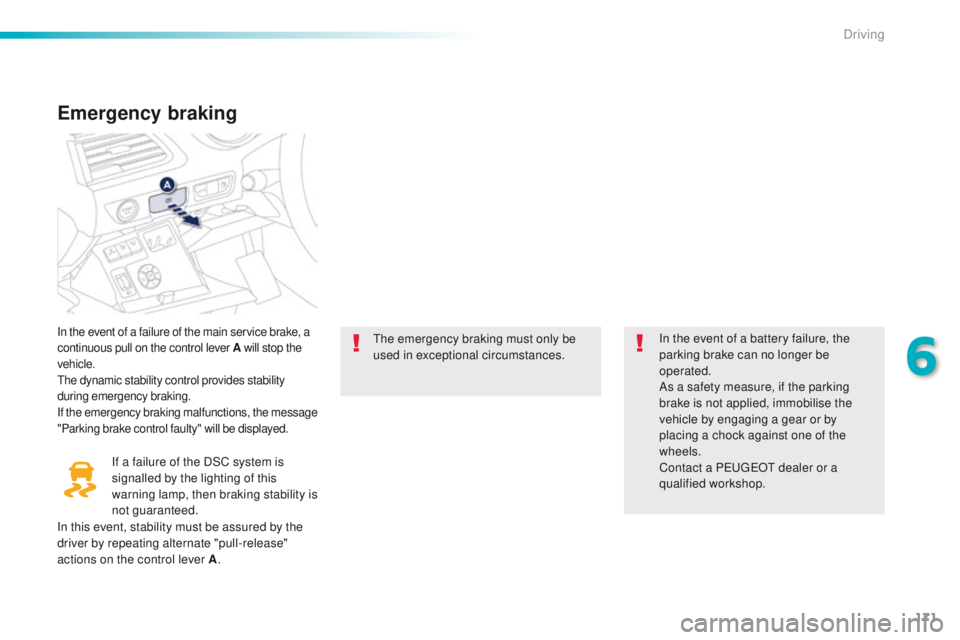
171
508_en_Chap06_conduite_ed01-2016
Emergency braking
In the event of a failure of the main service brake, a
continuous pull on the control lever A will stop the
vehicle.
th
e dynamic stability control provides stability
during emergency braking.
If the emergency braking malfunctions, the message
"Parking brake control faulty" will be displayed.
If a failure of the DSC system is
signalled by the lighting of this
warning lamp, then braking stability is
not guaranteed.
th
e emergency braking must only be
used in exceptional circumstances. In the event of a battery failure, the
parking brake can no longer be
operated.
As a safety measure, if the parking
brake is not applied, immobilise the
vehicle by engaging a gear or by
placing a chock against one of the
wheels.
Contact a Pe
ugeOt dealer or a
qualified workshop.
In this event, stability must be assured by the
driver by repeating alternate "pull-release"
actions on the control lever A .
6
Driving
Page 175 of 371
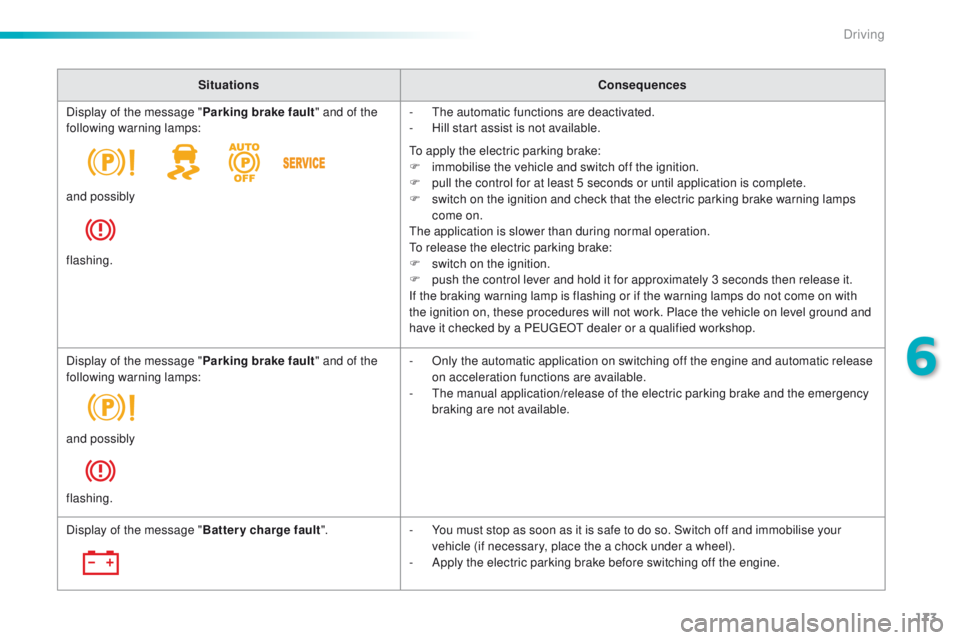
173
508_en_Chap06_conduite_ed01-2016
SituationsConsequences
Display of the message " Parking brake fault" and of the
following warning lamps: -
t
h
e automatic functions are deactivated.
-
H
ill start assist is not available.
to a
pply the electric parking brake:
F
i
mmobilise the vehicle and switch off the ignition.
F
p
ull the control for at least 5 seconds or until application is complete.
F
s
witch on the ignition and check that the electric parking brake warning lamps
come on.
th
e application is slower than during normal operation.
to r
elease the electric parking brake:
F
s
witch on the ignition.
F
p
ush the control lever and hold it for approximately 3 seconds then release it.
If the braking warning lamp is flashing or if the warning lamps do not come on with
the ignition on, these procedures will not work. Place the vehicle on level ground and
have it checked by a P
e
uge
Ot
dealer or a qualified workshop.
and possibly
flashing.
Display of the message "
Parking brake fault" and of the
following warning lamps: -
O
nly the automatic application on switching off the engine and automatic release
on acceleration functions are available.
-
t
h
e manual application/release of the electric parking brake and the emergency
braking are not available.
and possibly
flashing.
Display of the message " Battery charge fault".-
Y
ou must stop as soon as it is safe to do so. Switch off and immobilise your
vehicle (if necessary, place the a chock under a wheel).
-
A
pply the electric parking brake before switching off the engine.
6
Driving
Page 181 of 371
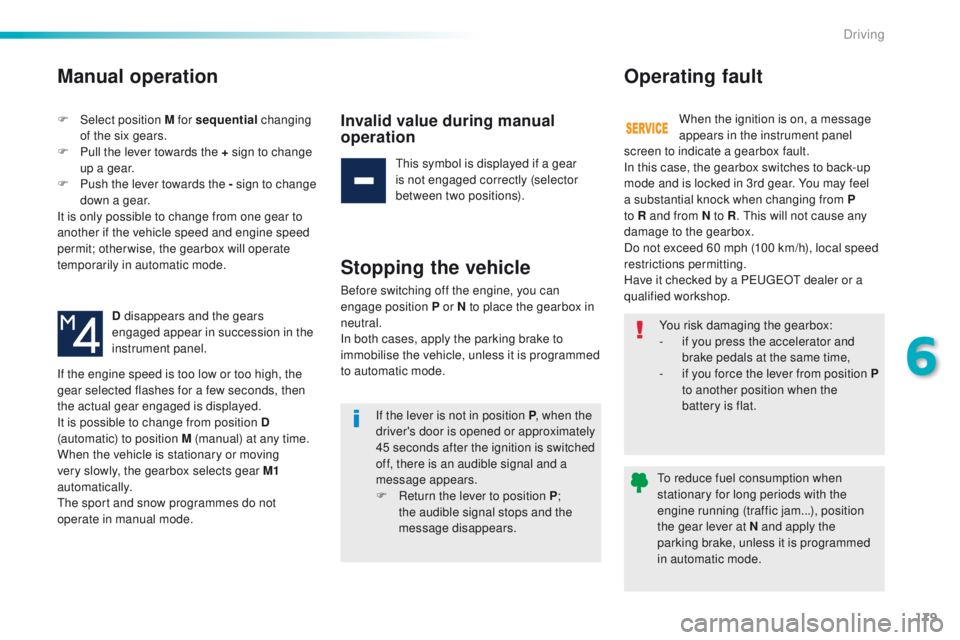
179
508_en_Chap06_conduite_ed01-2016
Manual operation
F Select position M for sequential changing
of the six gears.
F
P
ull the lever towards the + sign to change
up a gear.
F
P
ush the lever towards the - sign to change
down a gear.
It is only possible to change from one gear to
another if the vehicle speed and engine speed
permit; otherwise, the gearbox will operate
temporarily in automatic mode.
D disappears and the gears
engaged appear in succession in the
instrument panel.Invalid value during manual
operation
this symbol is displayed if a gear
is not engaged correctly (selector
between two positions).
Stopping the vehicle
Before switching off the engine, you can
engage position P or N to place the gearbox in
neutral.
In both cases, apply the parking brake to
immobilise the vehicle, unless it is programmed
to automatic mode.
Operating fault
When the ignition is on, a message
appears in the instrument panel
If the engine speed is too low or too high, the
gear selected flashes for a few seconds, then
the actual gear engaged is displayed.
It is possible to change from position D
(automatic) to position M (manual) at any time.
When the vehicle is stationary or moving
very slowly, the gearbox selects gear M1
automatically.
th
e sport and snow programmes do not
operate in manual mode. You risk damaging the gearbox:
-
i
f you press the accelerator and
brake pedals at the same time,
-
i
f you force the lever from position P
to another position when the
battery is flat.
If the lever is not in position P , when the
driver's door is opened or approximately
45 seconds after the ignition is switched
off, there is an audible signal and a
message appears.
F
R
eturn the lever to position P ;
the audible signal stops and the
message disappears.
to r
educe fuel consumption when
stationary for long periods with the
engine running (traffic jam...), position
the gear lever at N and apply the
parking brake, unless it is programmed
in automatic mode.
screen to indicate a gearbox fault.
In this case, the gearbox switches to back-up
mode and is locked in 3rd gear. You may feel
a substantial knock when changing from P
to R and from N to R
.
t
h
is will not cause any
damage to the gearbox.
Do not exceed 60 mph (100 km/h), local speed
restrictions permitting.
Have it checked by a P
e
uge
Ot
dealer or a
qualified workshop.
6
Driving
Page 183 of 371
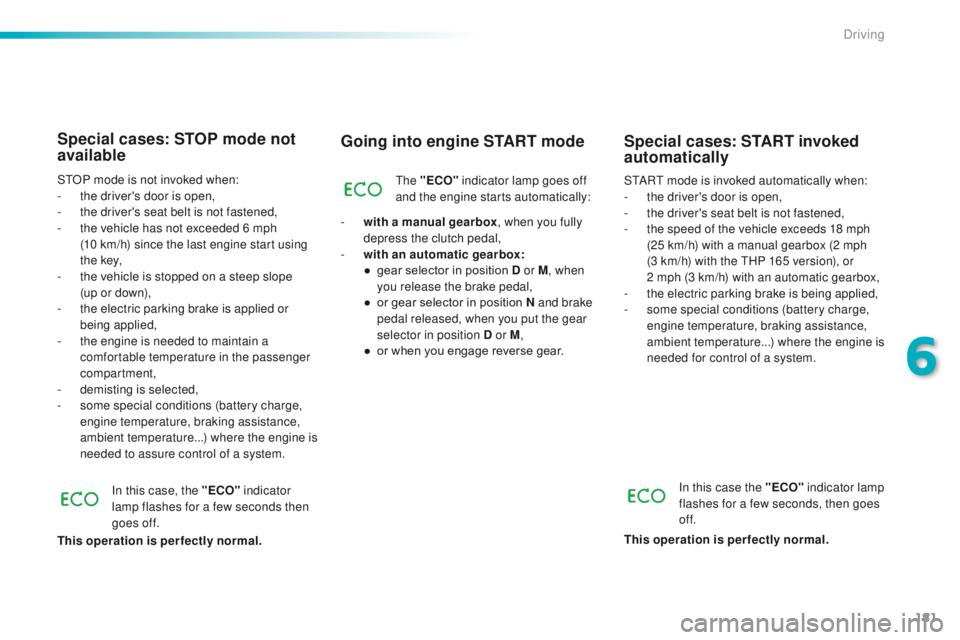
181
508_en_Chap06_conduite_ed01-2016
Going into engine START mode
the "ECO" indicator lamp goes off
and the engine starts automatically:
-
w
ith a manual gearbox , when you fully
depress the clutch pedal,
-
w
ith an automatic gearbox:
●
g
ear selector in position D or M , when
you release the brake pedal,
●
o
r gear selector in position N and brake
pedal released, when you put the gear
selector in position D or M ,
●
o
r when you engage reverse gear. StA
Rt mode is invoked automatically when:
- t he driver's door is open,
-
t
he driver's seat belt is not fastened,
-
t
he speed of the vehicle exceeds 18 mph
(25 km/h) with a manual gearbox (2 mph
(3 km/h) with the
t
H
P 165 version), or
2
mph (3 km/h) with an automatic gearbox,
-
t
he electric parking brake is being applied,
-
s
ome special conditions (battery charge,
engine temperature, braking assistance,
ambient temperature...) where the engine is
needed for control of a system.
Special cases: START invoked
automatically
In this case the "ECO" indicator lamp
flashes for a few seconds, then goes
of f.
This operation is perfectly normal.
Special cases: STOP mode not
available
StOP mode is not invoked when:
- t he driver's door is open,
-
t
he driver's seat belt is not fastened,
-
t
he vehicle has not exceeded 6 mph
(10
km/h) since the last engine start using
t h e key,
-
t
he vehicle is stopped on a steep slope
(up
or down),
-
t
he electric parking brake is applied or
being applied,
-
t
he engine is needed to maintain a
comfortable temperature in the passenger
compartment,
-
d
emisting is selected,
-
s
ome special conditions (battery charge,
engine temperature, braking assistance,
ambient temperature...) where the engine is
needed to assure control of a system.
In this case, the "ECO" indicator
lamp flashes for a few seconds then
goes off.
This operation is perfectly normal.
6
Driving